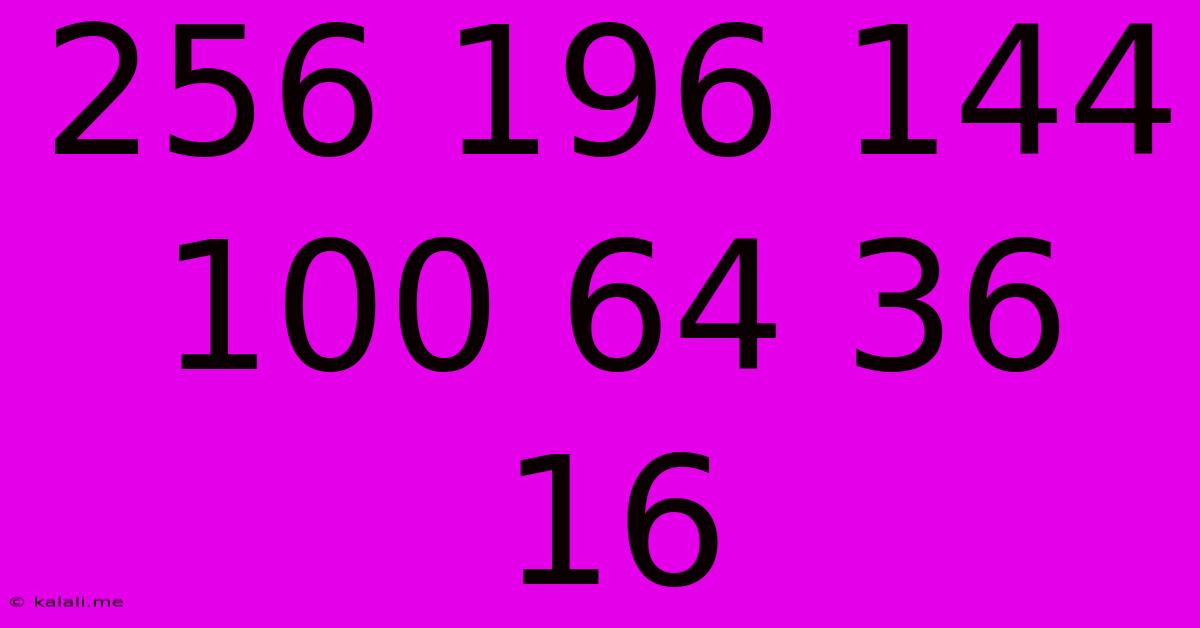256 196 144 100 64 36 16
Kalali
Jun 12, 2025 · 2 min read

Table of Contents
Decoding the Sequence: 256, 196, 144, 100, 64, 36, 16
This seemingly random sequence of numbers, 256, 196, 144, 100, 64, 36, 16, holds a fascinating mathematical pattern. Understanding this pattern not only unlocks the secret behind the numbers but also demonstrates a fundamental concept in mathematics. This article will delve into the solution, explaining the logic and offering insights into similar number sequences.
This sequence represents the squares of even numbers, decreasing in order. Let's break it down:
- 256: 16 x 16 (16 squared)
- 196: 14 x 14 (14 squared)
- 144: 12 x 12 (12 squared)
- 100: 10 x 10 (10 squared)
- 64: 8 x 8 (8 squared)
- 36: 6 x 6 (6 squared)
- 16: 4 x 4 (4 squared)
The pattern is clearly visible: each number is the square of an even integer, starting with 16 and decreasing by 2 each time. This makes it a simple, yet elegant arithmetic progression of squares.
Identifying Number Sequences: Tips and Techniques
Recognizing patterns in number sequences is a valuable skill, useful not only in mathematics but also in problem-solving and logical reasoning. Here are some tips to help you decipher similar sequences:
- Look for Differences: Calculate the differences between consecutive numbers. This can reveal linear or other predictable patterns. In our case, the differences between squares aren't immediately obvious, but the squares themselves reveal the pattern.
- Consider Squares and Cubes: Check if the numbers are perfect squares (like in our example) or cubes. Many sequences are based on these fundamental mathematical operations.
- Look for Common Factors: Identify if the numbers share any common factors. This can simplify the sequence and reveal hidden relationships.
- Examine the Sequence's Order: Determine if the sequence is ascending, descending, or alternating. This provides crucial context for understanding the pattern.
- Think Outside the Box: Sometimes, the pattern might be more complex, involving multiple operations or functions. Don't be afraid to explore different possibilities.
Extending the Sequence and Related Concepts
We can easily extend this sequence by continuing the pattern of decreasing even numbers squared:
- The next number would be 4 x 4 = 16 (already in the sequence, indicating a potential ending point).
This example perfectly illustrates the power of pattern recognition. Understanding the underlying mathematical structure allows us to predict the continuation or identify similar sequences.
Conclusion
The sequence 256, 196, 144, 100, 64, 36, 16 beautifully demonstrates the elegance and simplicity found within seemingly complex numerical arrangements. By understanding basic mathematical operations and applying systematic analysis, we can unravel the secrets behind these sequences and develop essential problem-solving skills. This exercise highlights the importance of observation, pattern recognition, and logical deduction in mathematical analysis.
Latest Posts
Latest Posts
-
Boiler Test Questions And Answers Pdf
Jun 13, 2025
-
What Is The Default File Extension For Powerpoint Presentations
Jun 13, 2025
-
What Is The Role Of Commutator In Dc Motor
Jun 13, 2025
-
Is Soil A Compound Element Or Mixture
Jun 13, 2025
-
National Film Award For Best Choreography
Jun 13, 2025
Related Post
Thank you for visiting our website which covers about 256 196 144 100 64 36 16 . We hope the information provided has been useful to you. Feel free to contact us if you have any questions or need further assistance. See you next time and don't miss to bookmark.